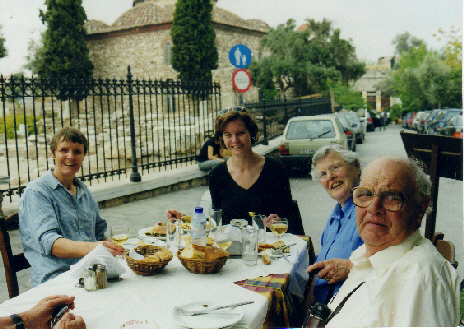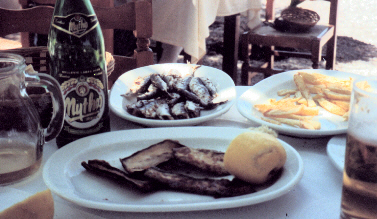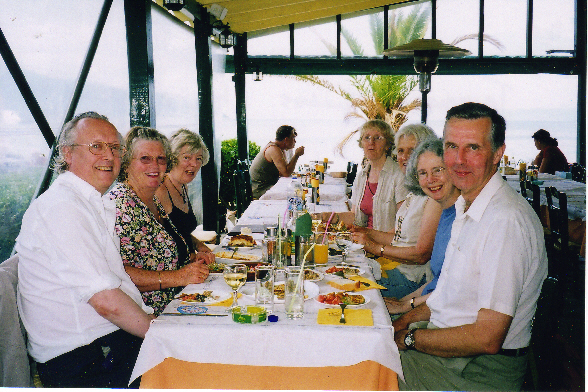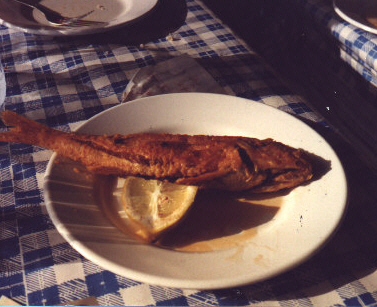Eating out in Greece

Lunch at the foot of the Acropolis
| Journey
through Ancient Greece
Eating out in Greece |
 Lunch at the foot of the Acropolis |
 |
You can eat out at anytime of the
day or night in Greece. The locals
tend to eat late, with lunch starting around 3pm and
dinner after 10pm (you won't cause raised eyebrows
arriving at midnight). Prices are fairly standard with
restaurants or tavernas on the tourist beaten track,
often with music, being slightly more expensive. Snack bars (Kanteenas) and take away food: You will find lots of places in Athens, and often at the sites, selling filled rolls and tir?es: cheese pies, spinak?es: spinach pies, souvl? me pita: kebab in pitta bread , also various sticky cakes dripping in honey such as baklav? |
 |
The
Taverna: This is the traditional Greek
restaurant, often somewhat scruffy looking, with small
square tables, with paper cloths, on the pavement often
across the road from the taverna. (Outward appearance is
no guide to quality of food!) Service is informal, and you can have as much or as little as you like; you can also linger as long as you like and won't be expected to make room for other diners. Menus are usually translated into English (sometimes with curious results), and waiters usually speak some English. If you don't understand and to ascertain what is available it is perfectly accepted practice to go in the kitchen and point to what you fancy. |
Some of the most common dishes you will come across are: As starters, (mez?es) or a
light lunch, or several as a meal: |
 Lunch time on Thasos |
Fish: There is often a wide choice of fish and sea food: calamari: squid, octopedi: octopus, glessa: sole, sinagrida: sea bream, tonnos: tunny. NB: The menu often shows these priced by the kilo. Be careful; it's difficult to judge what it will cost and can be expensive. Meat: In general the meat in Greece is of very good quality. You will usually find grilled (often on charcoal) arn?: lamb, arn?: mutton, khirin?,: pork and kot?li: chicken. Gyros is small pieces of pork with tsatsiki and salad and pitta bread, (often one portion is enough for two). Sometimes, under 'Today's Dishes', you will come across stif?: beef or rabbit with onions and tomatoes, or keft?es: meat balls, and of course mousaka. |
 |
| Drinks: Wine comes in bottles (buk?a), carafes (kar?), often an orange metal jug, or by the glass (pot?). The local wines (often ros?or rets? are the cheapest, often priced by the kilo, (a kilo carafe of retsina can cost as little as €2). Half carafes (500 gr) and quarter (250 gr) are available. Greek bottled non resinated wine can be as much as €10 and French wines, not often available, even more. Bottled beer, (bira)
commonly Amstel, Heineken and Mythos, is always
available, and occasionally, draught. Ouzo,
the aniseed flavoured spirit drunk by the Greeks at all
times of the day, is a very cheap, (and powerful!)
aperitif, although it is not available in all
restaurants. Metaxa is a
cheap and drinkable brandy, which comes in large
measures! Orange
juice (portakali) is often made from
fresh oranges. At site kanteens it can be
expensive (€3 but is very good. Coffee is complicated! Filter coffee is almost non-existent; the locals drink 'Greek coffee', a very strong brew in tiny cups. You'll be asked if you want milk 'me g?', or sugar: kaf?metrios (medium strength with little sugar) and kaf?sketos (without sugar). 'Nes' or Gallikos coffee if you want something less powerful. Frapp? iced coffee is widely available, as is hot chocolate. Note: You will notice that the coffee shops or 'kafenion' are men only refuges! For mixed company try the 'zacharoplsteion' where you can have coffee and cakes. |
Music at Xinou's taverna, Athens |
For good Greek food in Athens click here Greek restaurants elsewhere: Delphi http://www.vakchos.com/index.htm Thessaloniki: http://www.bitbazaar.gr/MainEn.asp Ioanina: www.seirioskouzina.gr Corfu: www.restaurantrex.gr Cardiff www.aegeantaverna.co.uk |